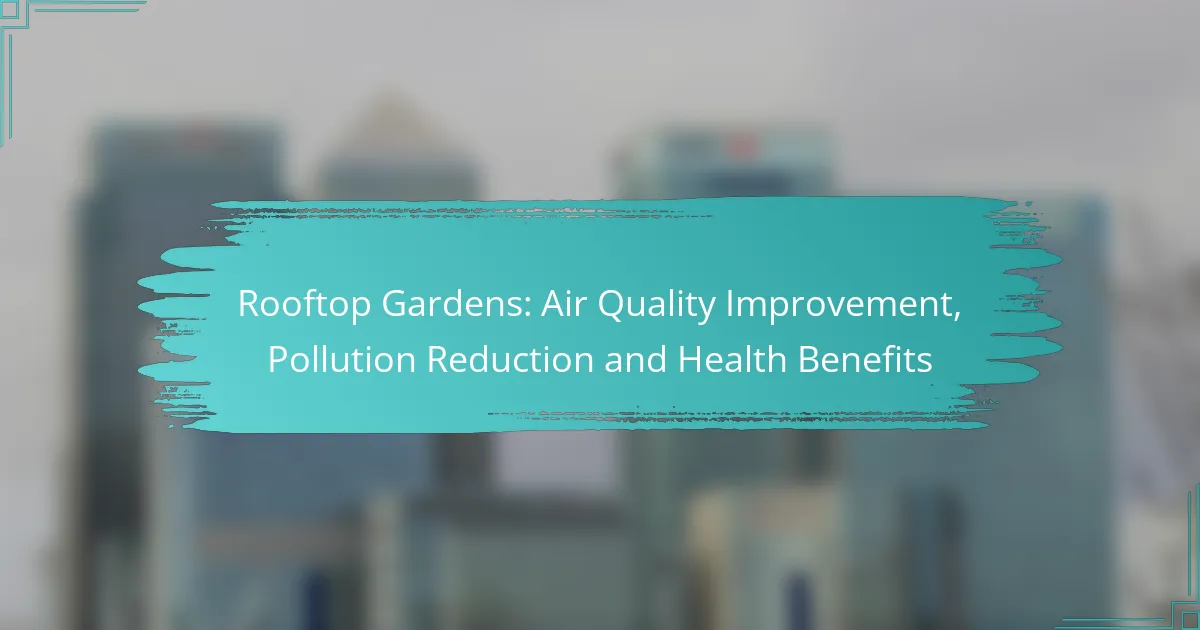Rooftop gardens serve as vital green spaces in urban environments, significantly improving air quality by filtering pollutants and producing oxygen. They not only combat the adverse effects of urbanization on air pollution but also offer health benefits such as enhanced mental well-being and opportunities for physical activity.
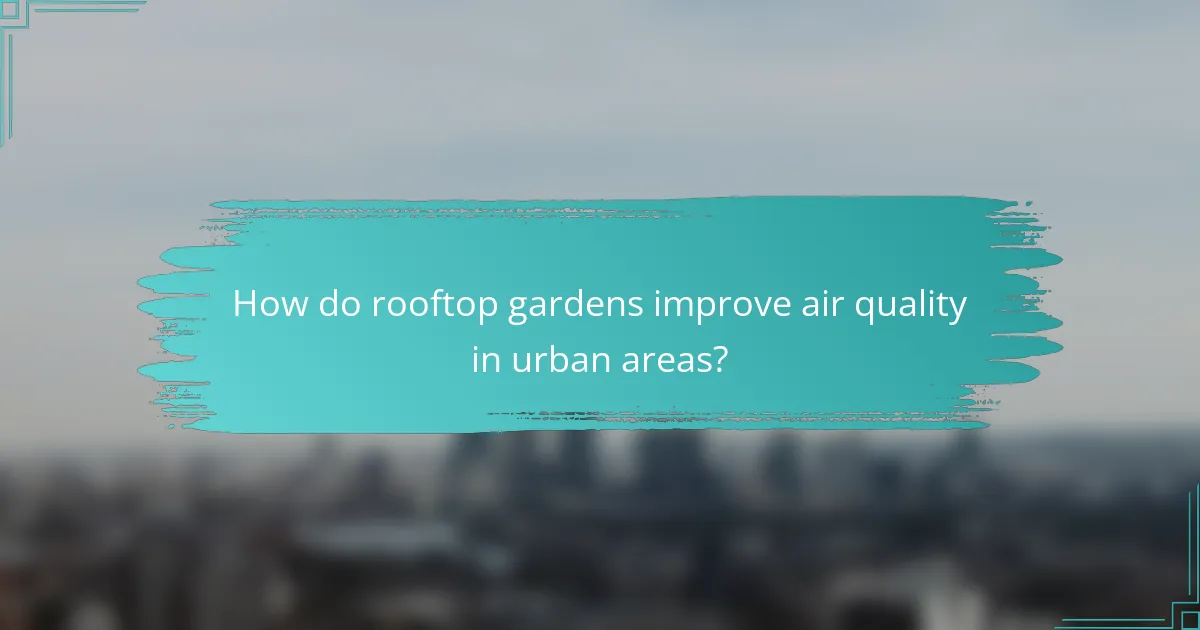
How do rooftop gardens improve air quality in urban areas?
Rooftop gardens enhance air quality in urban settings by filtering pollutants and providing essential oxygen. These green spaces play a crucial role in mitigating the effects of urbanization on air pollution.
Reduction of particulate matter
Rooftop gardens effectively reduce particulate matter, which includes dust, soot, and smoke that can harm respiratory health. The plants in these gardens capture and trap these particles, preventing them from entering the atmosphere.
Studies suggest that green roofs can lower particulate matter levels by up to 50%, depending on the plant species and design. Incorporating a variety of plants can maximize this effect, as different species have varying capacities for trapping pollutants.
Absorption of carbon dioxide
Rooftop gardens absorb carbon dioxide (CO2), a major greenhouse gas contributing to climate change. Through the process of photosynthesis, plants convert CO2 into oxygen, thereby reducing the overall concentration of this pollutant in the air.
On average, a well-maintained rooftop garden can absorb several tons of CO2 annually. Choosing native and drought-resistant plants can enhance CO2 absorption while minimizing water usage, making the garden more sustainable.
Increase in oxygen production
Rooftop gardens significantly increase oxygen production, which is vital for urban air quality. Through photosynthesis, plants release oxygen, improving the air we breathe in densely populated areas.
A diverse selection of plants can boost oxygen levels, with leafy species being particularly effective. For optimal results, consider integrating a mix of shrubs, grasses, and flowering plants to maximize oxygen output and create a vibrant ecosystem.
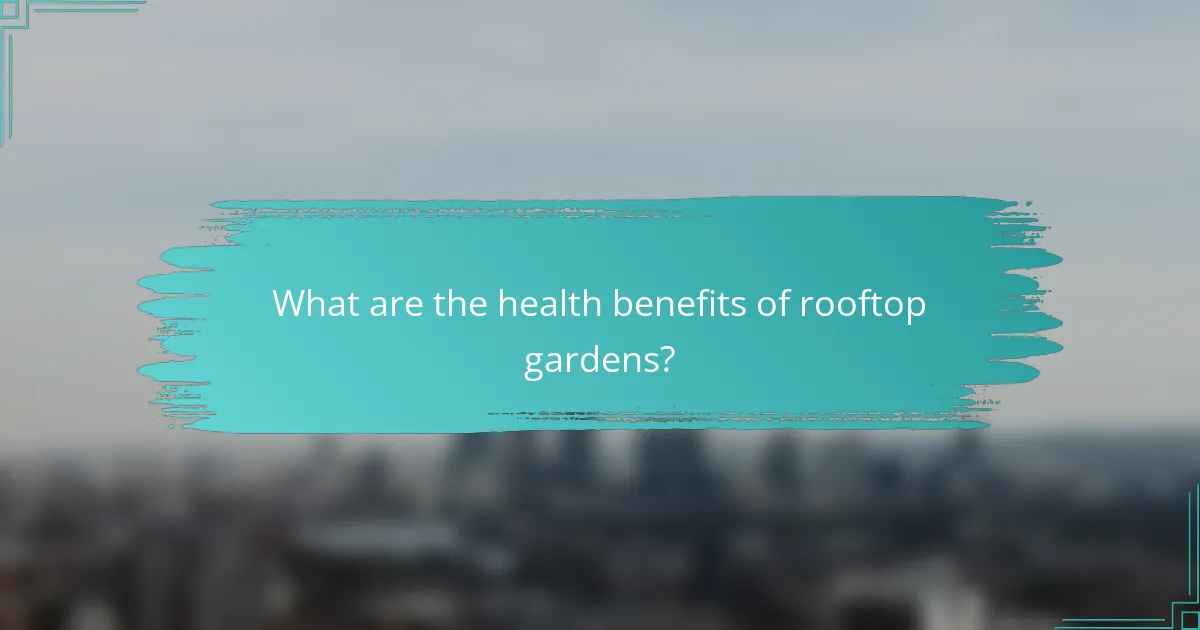
What are the health benefits of rooftop gardens?
Rooftop gardens offer numerous health benefits, including improved air quality, enhanced mental well-being, and increased physical activity. These green spaces help mitigate urban pollution and provide a tranquil environment for relaxation and exercise.
Stress reduction and mental health improvement
Rooftop gardens can significantly reduce stress and improve mental health by providing a serene escape from the hustle of city life. The presence of greenery has been shown to lower cortisol levels, which are associated with stress. Spending time in these gardens can promote mindfulness and relaxation, contributing to overall emotional well-being.
Engaging with nature, even in small urban spaces, can enhance mood and reduce feelings of anxiety. Activities such as tending to plants or simply enjoying the view can foster a sense of accomplishment and connection to the environment.
Enhanced physical health through gardening
Gardening in rooftop spaces encourages physical activity, which can lead to improved cardiovascular health and increased strength. Regular gardening tasks, such as planting, weeding, and watering, can provide a moderate workout that benefits overall fitness levels.
Moreover, rooftop gardens can promote healthier eating habits by providing access to fresh fruits and vegetables. Growing your own produce encourages a diet rich in nutrients, which can have long-lasting health benefits. Incorporating gardening into your routine can be a fun and effective way to stay active and improve your diet.

How do rooftop gardens reduce pollution?
Rooftop gardens reduce pollution by improving air quality and mitigating the urban heat island effect. They absorb carbon dioxide and other pollutants while providing a natural filtration system that enhances the overall environment.
Mitigation of urban heat island effect
Rooftop gardens help combat the urban heat island effect by cooling buildings and surrounding areas. This cooling effect can lower ambient temperatures by several degrees, reducing the need for air conditioning and subsequently decreasing energy consumption.
By using vegetation to absorb sunlight and provide shade, rooftop gardens can significantly lower surface temperatures. This not only benefits the immediate area but also contributes to a more comfortable urban climate overall.
Filtration of air pollutants
Rooftop gardens act as natural filters for air pollutants, capturing dust, smoke, and other harmful particles. The plants and soil in these gardens absorb and break down pollutants, improving the air quality for residents and workers in urban environments.
Research indicates that green roofs can reduce particulate matter by a notable percentage, enhancing the health of city dwellers. Incorporating a variety of plants can maximize this filtration effect, as different species have varying capacities for absorbing specific pollutants.
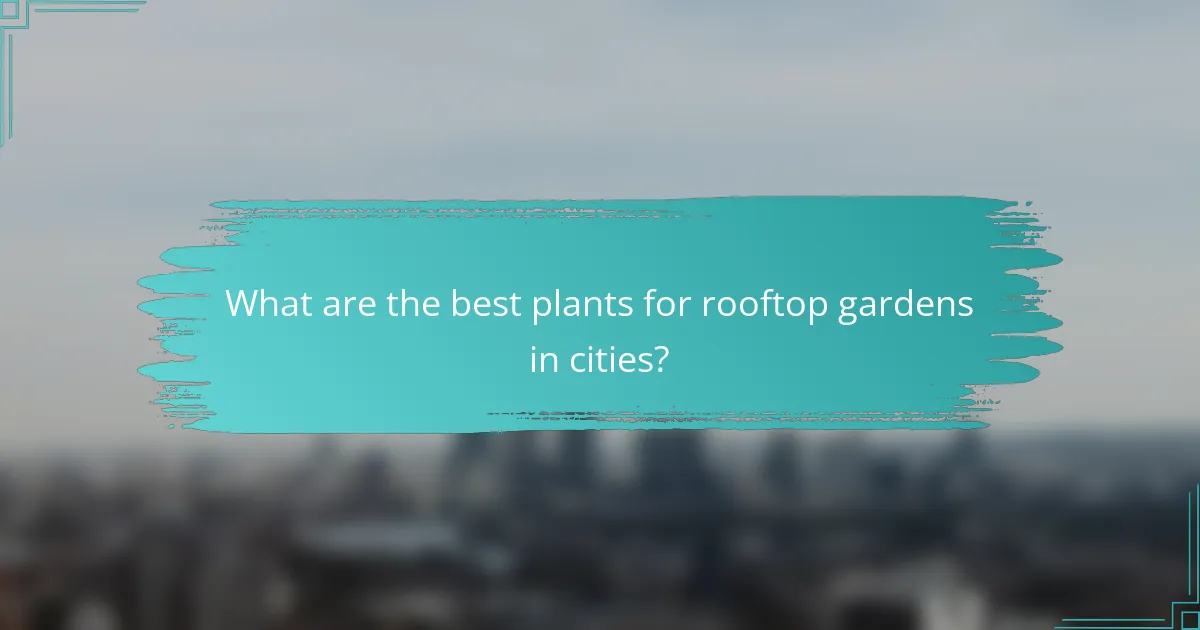
What are the best plants for rooftop gardens in cities?
The best plants for rooftop gardens in cities are those that thrive in limited soil depth, tolerate wind, and can withstand varying temperatures. Selecting the right plants can enhance air quality, reduce pollution, and provide health benefits to urban dwellers.
Native plant species
Native plant species are well-adapted to local climates and soils, making them ideal for rooftop gardens. They require less water and maintenance compared to non-native varieties, which is particularly beneficial in urban settings where resources may be limited.
Examples of native plants include coneflowers, black-eyed Susans, and various grasses. These species not only support local ecosystems but also contribute to improved air quality by filtering pollutants.
Pollinator-friendly plants
Pollinator-friendly plants attract bees, butterflies, and other beneficial insects, which are crucial for maintaining biodiversity in urban areas. Incorporating these plants into rooftop gardens can help support pollinator populations that are often threatened by habitat loss.
Consider planting species such as lavender, bee balm, and milkweed. These plants provide nectar and pollen, making your rooftop garden a vibrant ecosystem that enhances both beauty and environmental health.

What are the costs associated with installing a rooftop garden?
The costs associated with installing a rooftop garden can vary widely based on factors such as size, design, and materials. Generally, you can expect initial setup costs to be substantial, while ongoing maintenance expenses will also need to be considered for long-term sustainability.
Initial setup costs
Initial setup costs for a rooftop garden typically range from several thousand to tens of thousands of dollars. Key factors influencing these costs include the type of plants chosen, the structural modifications needed to support the garden, and the installation of irrigation systems.
For example, a simple container garden may require a lower investment compared to a more complex green roof system that includes soil layers and drainage. It’s advisable to obtain multiple quotes from contractors specializing in green roofs to ensure competitive pricing.
Maintenance expenses
Maintenance expenses for rooftop gardens can vary, but you should budget for regular upkeep, which may include watering, fertilizing, and pest control. On average, annual maintenance costs can range from a few hundred to a couple of thousand dollars, depending on the garden’s size and complexity.
Consider hiring a professional service for larger installations, as they can provide expertise in plant care and landscape management. Regular maintenance not only keeps the garden healthy but also enhances its aesthetic appeal and longevity.
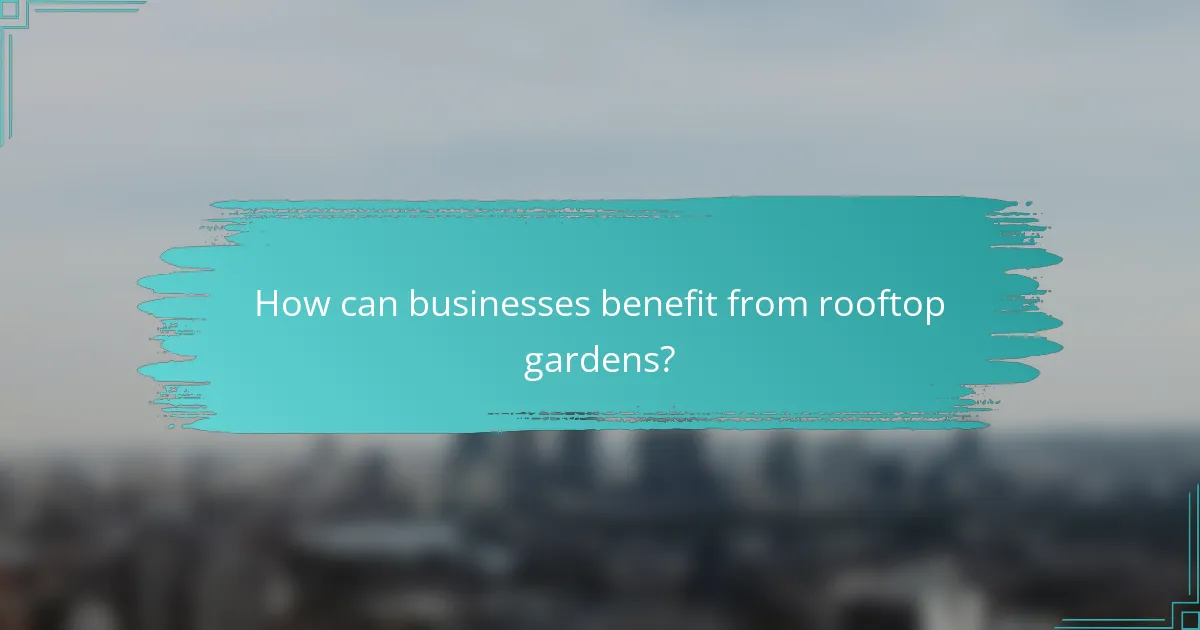
How can businesses benefit from rooftop gardens?
Businesses can gain numerous advantages from rooftop gardens, including improved air quality and enhanced employee satisfaction. These green spaces not only contribute to a healthier work environment but also promote sustainability, which can positively impact a company’s reputation.
Improved employee well-being
Rooftop gardens can significantly enhance employee well-being by providing a serene environment that encourages relaxation and social interaction. Access to green spaces has been shown to reduce stress, boost mood, and increase overall job satisfaction.
Incorporating nature into the workplace can lead to higher productivity levels. Employees who spend time in these gardens often report feeling more energized and focused, which can translate into better performance and lower absenteeism rates.
Enhanced brand image and sustainability
Implementing rooftop gardens can elevate a company’s brand image by showcasing a commitment to sustainability and environmental responsibility. This initiative can attract eco-conscious clients and customers who value green practices.
Additionally, businesses can leverage their rooftop gardens in marketing efforts, highlighting their efforts to combat urban pollution and promote biodiversity. This not only enhances public perception but can also lead to potential partnerships with local environmental organizations.
